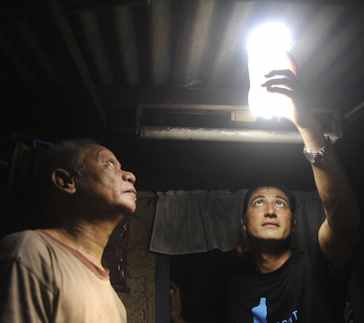
“You wanna take a look?” goes Mifune Japanese Restaurant’s teaser on its website. “Feel free to ask our waitresses to have a look in our back kitchen! Picture-taking is allowed. School classes, students, (and) researchers are welcome…. ”
The attraction? Three 1.5-liter plastic soft-drink bottles, filled with water and a little bleach, poke out of the restaurant’s back kitchen roof, illuminating the whole room without using electricity from morning till sundown.
The not-so-secret ingredient: The upper-half part of each plastic bottle juts out above the restaurant’s metal roof and catches sun light; the water’s refractive property then disperses the light 360 degrees inside the restaurant’s back kitchen, like how a 55-watt electric bulb would light up a room. The bleach is for preventing the growth of algae inside the bottle, so the improvised solar light bulb would last for around five years before it’s replaced. No sweat replacing the contraption, though, as the materials are found everywhere, no need for high-skilled labor, and the cost is close to zero.
The restaurant has recently adopted the solar bottle bulb idea of “A Liter of Light,” the latest project of seven-year-old MyShelter Foundation, whose unorthodox ideas to solve common social problems have earned worldwide recognition for its founder and executive director, Illac Diaz, including from the World Economic Forum (WEF) and the United Nations Framework Convention on Climate Change (UNFCCC).
Lighting up dark communities and businesses
For one, the utterly simple technology of A Liter of Light has lit up over 200,000 homes in otherwise bleak communities in the Philippines and around the globe since its launch in 2011.The solar bottle bulb is actually meant for the indigent and those living in off-grid, dark places and where electric power is unreliable. It certainly won’t hurt, though, if higher social classes and businesses like Mifune Japanese Restaurant try it out, too. Diaz says another restaurant in Zamboanga has adopted the A Liter of Light’s solar bottle bulb as well.
Diaz attributes the invention of the solar bottle bulb to Alfredo Moser, a Brazilian engineer who improvised the device to light his workshop in 2002 when his neighborhood in Sao Paolo, Brazil was suffering through a long cut in electric power. Soon, his neighbors followed suit.
Diaz scaled up the idea to a social enterprise in the Philippines, and soon in other countries, as he looked for logistic support for the project abroad. From a small town in Laguna, the humble but ingenious technology has spread to the cities of Manila and San Juan, up north to Baguio and down south to Negros and Zamboanga. Thanks mainly to MyShelter Foundation’s volunteers.
Key strategies, volunteers
It’s only natural for non-profits to bank on donations for their projects. But A Liter of Light also employs three key strategies for its success: volunteers, social media, and the “grassroots entrepreneur” business model.
The group hopes to light up a million abodes by 2015.
“But how do you light millions of houses without being a million-dollar company?” Diaz asks, then answers himself: “Volunteers!”
“We, Filipinos, are great at people power; why not maximize it?” His foundation trains volunteers, mostly youth and some business companies, on how to make the solar bottle bulb and then troop to low-income communities to also teach the locals.
The Manila office of Thomson Reuters, the world’s largest news and information Services Company, was among the first corporate volunteer groups to help Liter of Light install solar bottle bulbs in Metro Manila’s poor communities.
“It’s one of our favorite CSR (corporate social responsibility) activities,” says Marla Alvarez, Strategy and Communications Manager at Thomson Reuters Manila. The company has opted to have its predominantly young, energetic, and enthusiastic employees climb up rooftops in Metro Manila’s cramped shanty towns than shell out huge corporate funds. But then again, Alvarez says Thomson Reuters Foundation is considering rewarding A Liter of Light with a grant amounting to anywhere from US$5,000 to US$25,000 under the company’s Community Champion Awards.
“Grassroots enterprise” business model
Perhaps, if he were still alive, “Small is Beautiful” author, late German economist E.F. Schumacher, would have applauded A Liter of Light. The movement advocates Schumacher’s philosophy of “alternative technology,” to empower the powerless, quite literally.
“In a way, we’re doing it—Schumacher’s “Small is Beautiful” concept,” says Diaz, “since all the materials are found in the community, not costly, and the product is simply built with simple tools. We don’t want dependency on expensive imported materials and complex technology from big industries. This low-technology device has no patent and anybody could do it.”
Diaz—who studied at Ateneo from Prep to College with a bachelor’s degree on Management Economics, mastered Entrepreneurship at Asian Institute of Management, Urban Planning at Massachusetts Institute of Technology, and Political Administration in Harvard—stresses that the ease of replicating the solar bottle bulb spells the livelihood component of the device, as well as its sustainability.
Beneficiaries of the solar bottle bulb swear their lives have been better, as they can now engage in simple enterprises like small neighborhood stores, their children now study better, and most of all, they now save up some money for needs other than electricity.
Likewise, those who have mastered doing the device—some were previously unemployed—have eked out a living by making and installing it on their neighbors’ houses for some fee.
“Appropriate Technology concept can be adopted by businesses and individuals,” says e-business consultant Collins Olua in the blog e-journals, stressing that reviewing business operations with common sense and some creativity might at the end yield significant cost cuts and competitive advantage.
“Simplicity still pays,” he says.
One Response
And for after dark, the UVPaqlite Matt Lite may be of some use. Surely not 55 watt bright, but better than nothing! I have a few of their products (glow stick, donut pendant and scout lite and the darker it is, the more illumination you get.